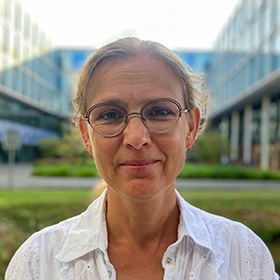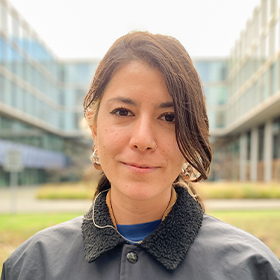Dit artikel is momenteel alleen beschikbaar in het Engels.
Science and technology are fundamental for our society’s progress. Jobs in these fields are proliferating, and they usually offer good career prospects. Additionally, scientific skills and reasoning are essential for our daily activities. We shouldn’t leave anybody behind, but there exist gender disparities in STEM from school to job.
Women have been historically excluded from power positions and science books. There are still many myths about who is and who isn’t a “maths person” or preconceived ideas about what a scientist looks like. Women are still harmed by negative stereotypes that limit their interest in STEM and make them believe they are less able than men to pursue careers in this field.
We need to get rid of barriers like low expectations in science subjects for girls, inadequate career guidance, sexist language at work and education, everyday biases that undermine women’s authority, hiring processes that discriminate against women, male-dominated cultures, etc.
Role models and gender equality interventions are necessary to let everybody be aware of what women can achieve, and encourage female students to fulfill their potential.

For International Women’s Day, we wanted to raise awareness about the discrimination that women in STEM face, so we decided to start by looking inward, into our own company.
Although we perceive that there is a general sense of equality at our workplace, we talked with some of our female colleagues to detect and prevent potential problems. We share their experiences to inspire other women in STEM, and women interested in working in this sector. We have interviewed:

Paula Beukers
STEM Editor | From the Netherland
Paula has a strong background in mathematics and educational science. Her last positions as teacher and educational developer with a strong focus on e-learning in higher education brought her to Sowiso and OMPT. Here she is involved in ensuring the quality and validity of the online math placement tests.

Ana Lucia Vargas Sandoval
Product Owner | From Mexico
Ana Lucia has a PhD in Mathematical Logic. During her years as an academic, she was inspired by the purpose of education, the commitment of teachers, and the role of technology in the learning experience. At Sowiso, she takes part in the development and management of new products, improving the existing ones, and analyzing the relevant processes to support our existing and new business models. In this regard, she builds up and maintains our customers’ trust in our products, ensuring their satisfaction.

Angelina Momin
Author | From Bangladesh
Angelina first started as an intern, and then she chose to keep working with us. Now she works on our automated feedback and enhances the capabilities of our Virtual Teaching Assistant.
Early in our childhood, we already get questions from grown-ups around us: “What are you going to be when you grow up?” The answer to this question will be influenced by many factors: our parents, teachers, media we consume. We look for role models who will inspire us to pursue a certain career path later in life. For Ana Lucia, it was her father who first sparked her interest in STEM:
“When I was 8 I already knew I wanted to be a scientist. I was interested in physics and astrophysics because my dad showed me a telescope, and I was inspired by that. It sounded cool to me, and I admired the scientists. My dad was formed also as a scientist, so I had a connection with him about that.” (Ana Lucia)
Girls that dream of working in STEM quickly see the other side of this career path once they embark on their journey through education. As there are traditionally more male than female students in STEM, studying can feel lonely and isolating.
“I started studying mechanical engineering, and that was with 500 men and 5 women. At my first job, I was the only woman in my team in the ICT department. That has definitely shifted over the years.” (Paula)
Nowadays, we can see how the number of female students in STEM is increasing. Our youngest interviewee, Angelina, found more women on her campus (although there were far more women in courses like sociology than in physics).
In the future, we hope gender norms stop affecting our career choices. Students should be able to choose their own paths and fulfill their dreams regardless of these prescriptive social expectations.

We feel lucky to live and work in a country where the level of gender equality is higher than in other places. However, there is still work to do, and our colleagues mention previous experiences of discrimination. For example, Paula told us how in other companies, after explaining something to somebody, this person asked another male coworker because he didn’t trust her answer.
Ana Lucia also shared how she had to prove herself more than her male colleagues in academia:
“I had a feeling that I had to prove myself more. Even when I was giving presentations at conferences. My male colleagues were giving talks, and they would also joke with the audience. I felt that I had to put on a serious mask, and I never felt like I could be playful like my male colleagues. Us women presenters had to dress in a certain way, preferably all black, not to distract with a red dress that you might want to wear.” (Ana Lucia)
As we can see, in the Netherlands, women working in STEM still experience discrimination and unequal treatment. It’s important to listen to these individual experiences and make them heard so that we can work towards a change.
Additionally, we have to be aware of how other variables like ethnicity, age, or nationality intersect with gender. All of these variables are interconnected and fall under the inclusivity umbrella. We should strive towards equality in all of these aspects.

Sowiso’s mission is to improve STEM education, and most of our employees are STEM majors. We asked our colleagues to reflect on the atmosphere of our company and share their experience of working at Sowiso as women. We covered topics like our hiring process and their day-to-day working life. These were their answers:
“Once you are hired, it’s very clear that we are a nice and balanced company. But you don’t get that impression when you are looking into the position. Even on the website, our videos on YouTube are made by our male colleagues. It would be nice to see women represented as well.” (Ana Lucia)
“It feels to me that we just hire people for quality. We are also a very international company. I don’t have a feeling that people don’t work with each other because of gender or where they come from. We don’t care if somebody is a woman or a man, as long as you do your job. I like this company for that.” (Paula)
“I have never felt discriminated against when working at Sowiso merely because I am a woman. Personally, I have always felt that the company is mainly concerned about whether an individual has the required skills for their job and that’s it— one’s gender does not change the way someone is treated in the company.” (Angelina)
Our colleagues agree that they don’t feel treated differently than men for being women. But, as Ana Lucia mentioned, during the hiring process we can work on being more clear about where we stand on gender equality. As a society, we are still not at a point where we can take equality for granted, so we should voice our opinion on equality through statements and actions.
When we asked them what makes them feel empowered, confident, and proud at their jobs, our colleagues replied:
“My experience and knowledge. I know that the job that I’m hired to do, I can do. And I feel proud of contributing to this amazing e-learning platform that makes STEM education accessible for anyone.” (Paula)
“Being part of a company which works on education, especially mathematics and STEM education. Education is obviously so important for people. As a mathematics graduate, I can really resonate with the fact that the way in which mathematics is taught can sometimes hinder people’s enjoyment of the subject. That was the case for me in high school. It is very meaningful for me to be able to work in the development team of a company that wants to change the landscape of online STEM education and create engaging, interactive content that makes the process of learning more fun and easy.” (Angelina)
“I feel empowered when my work is respected and appreciated, together with my voice and opinion. I also feel empowered by my female colleagues and the energy I get from them. It’s very different from being around just men. There was a point when I was the only woman in the commercial team and these guys are amazing, they are always welcoming my ideas with open ears and open minds. It’s just nice how the perspective and opinion exchange get enriched by having a very diverse group of people.” (Ana Lucia)

Sowiso Team
We also asked our CEO, Marc Habbema, about his views on gender equality. This is what he replied:
“I am really proud that we’re able to offer a place where there’s a lot of room and respect for different types of people with different qualities and backgrounds (we employ 15 different nationalities!). I experience that we’re a stronger team because we are this diverse and we benefit from everyone’s individual personality and skills.”
Our company has grown a lot in the last year. The size of our team doubled in 2021. All our interviewed colleagues have been working here from six months to one year and a half. And one of our challenges is maintaining our inclusive culture as we evolve. As Marc said:
“Since we’re growing fast as a company, we will formalize and quantify more gender-related procedures and targets. But more importantly: as long as I will work here, I will help cherish and nurture the open and inclusive working atmosphere we currently have. Providing employees with challenging and rewarding work is important, but doing so in a fun and safe space to work within is even more important.”
This is how he tries to make the company an inclusive place from the recruitment process onwards:
“We make sure that the vacancy text does not show any gender preference and are aware that some words in a vacancy can be masculine or feminine and try to avoid that. During the recruitment process, we make sure that the candidate gets to meet different people from our organization, preferably from different genders, ages, and backgrounds. Our statistics show that we have been successful in achieving equality in the hiring process; 13 out of our current 31 employees are female, which is pretty impressive for a tech company.”
If somebody feels uncomfortable or discriminated against: “We’ve got both an internal and external confidentiality counselor so that professional help is never far away. Fortunately, we never had an issue.”
Despite the positive feedback we have received from our colleagues, we want to continue improving and not take anything for granted. During this reflection process, we have also noticed some things we could improve (like the male to female ratio in our development team, having an inclusive statement in our vacancies, our equality policies, and increasing female presence on our website). Creating an inclusive workplace should be an ongoing process.
We will keep learning and having open conversations about inclusivity at our work and our platform. And, of course, we will analyse how gender intersects with other variables like ethnicity, age, or nationality to make sure we consider the full picture. We want to help everybody thrive personally and professionally.
These are the personal opinions of a few people we interviewed, we do not represent all women. If you have any questions or suggestions, please reach out to us at support@sowiso.com.